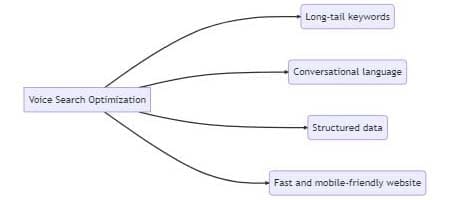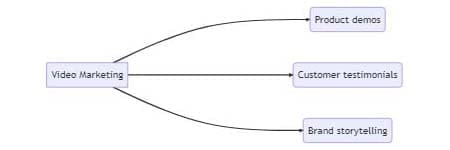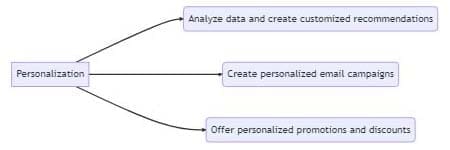Local Digital Marketing Trends in 2023: Your Map to Success
Just like a map helps you navigate unfamiliar territory, keeping up with the latest local digital marketing trends is essential to steer your business in the right direction. In 2023, there are several trends that you need to know to ensure that you’re not left behind in the race.
Think of these trends as landmarks on your map. They’ll help you identify your location, your competitors, and your target audience. They’ll also show you the best route to your destination, whether it’s increased brand awareness, higher customer engagement, or better sales.
So, let’s explore the top local digital marketing trends in 2023 and see how they can be your map to success.
How Artificial Intelligence and Machine Learning are Revolutionizing Marketing in 2023

Artificial Intelligence (AI) and Machine Learning (ML) have been making waves in the marketing industry, and the buzz around them is only set to grow louder in 2023. Experts predict a staggering 300% increase in their usage, and for a good reason. These cutting-edge technologies have revolutionized the way businesses approach marketing, offering unprecedented insights into customer behavior and personalizing experiences like never before.
 Unleashing the Power of AI and ML in Marketing
Unleashing the Power of AI and ML in Marketing
The benefits of leveraging AI and ML in marketing are many. From analyzing customer behavior to streamlining operations, businesses can make data-driven decisions and stay ahead of their competitors. Let’s take a closer look at some of the most exciting applications of these technologies in the marketing world.
- Personalized Marketing: AI and ML enable businesses to tailor marketing messages to individual customers. By analyzing data on customer behavior, preferences, and demographics, businesses can create personalized experiences that resonate with their audience. This not only leads to higher engagement but also builds stronger relationships with customers.
- Automating Routine Tasks: With AI and ML, marketers can automate repetitive tasks like scheduling social media posts and generating personalized email campaigns. This frees up valuable time for more strategic tasks like developing new campaigns, analyzing data, and identifying trends.
- Predictive Analytics: By analyzing patterns in customer behavior, AI and ML can help businesses predict future actions and behaviors. This enables marketers to create more targeted and effective campaigns that drive better results.
- Streamlining Operations: AI and ML can help businesses optimize their operations by automating processes and identifying inefficiencies. This can result in cost savings, faster time-to-market, and a more agile business.
The Future of Marketing with AI and ML
The potential of AI and ML in marketing is enormous. As these technologies continue to evolve, we can expect even more advanced applications, such as augmented reality and chatbots. But with all the excitement around AI and ML, it’s important to remember that these technologies are only as good as the data they’re based on. Marketers need to ensure they have quality data that is relevant and up-to-date.
AI and ML are transforming the marketing landscape, offering businesses unprecedented insights into customer behavior and personalized experiences. From automating routine tasks to predictive analytics, these technologies are enabling businesses to stay ahead of their competitors and make data-driven decisions. As we look to the future, it’s clear that AI and ML will continue to play a key role in shaping the marketing industry.
Optimize Your Business for Voice Search

Voice search is changing the game for businesses of all sizes. With over half of the households expected to have a smart speaker by 2023, optimizing for this new way of searching is becoming increasingly important. Let’s cover some tips to help you make the most of voice search for your business.
Using Long-Tail Keywords
 Long-tail keywords are phrases that are more specific and targeted than broad keywords. They are often used in voice search because they are more conversational and mimic the way people speak. By including long-tail keywords in your content, you increase your chances of appearing in voice search results.
Long-tail keywords are phrases that are more specific and targeted than broad keywords. They are often used in voice search because they are more conversational and mimic the way people speak. By including long-tail keywords in your content, you increase your chances of appearing in voice search results.
For example, if you’re a pizza restaurant, you could use long-tail keywords like “best pizza delivery near me” or “fast pizza delivery.” These phrases are more specific than simply “pizza delivery” and are more likely to match the way someone would search using voice.
Using Conversational Language
When optimizing for voice search, it’s important to use conversational language. Voice search is designed to mimic natural conversation, so using more natural language in your content can help you rank higher.
For example, instead of just including a list of menu items on your website, you could include conversational prompts like “What’s good for dinner tonight?” or “What are your specials for the week?” This type of language is more likely to match the way someone would search using voice.
Using Structured Data
Structured data is a way of organizing and marking up content on your website so that search engines can understand it better. By using structured data, you can provide more context about your content and make it easier for search engines to match your content to voice search queries.
For example, you could use structured data to mark up your menu items with information like price, ingredients, and calorie count. This makes it easier for search engines to provide more detailed answers to voice search queries about your menu.
Having a Fast and Mobile-Friendly Website
 Finally, it’s important to have a fast and mobile-friendly website when optimizing for voice search. Most voice searches are conducted on mobile devices, so having a website that loads quickly and is easy to navigate on a small screen is crucial.
Finally, it’s important to have a fast and mobile-friendly website when optimizing for voice search. Most voice searches are conducted on mobile devices, so having a website that loads quickly and is easy to navigate on a small screen is crucial.
Make sure your website is optimized for mobile devices and uses a responsive design that adjusts to different screen sizes. You should also ensure your website loads quickly by optimizing images, caching, and minimizing HTTP requests.
Optimizing for voice search is becoming increasingly important as more and more people adopt smart speakers and other voice-enabled devices. Using long-tail keywords, conversational language, structured data, and a fast and mobile-friendly website can increase your chances of appearing in voice search results and attract more customers to your business. So don’t wait, start optimizing for voice search today!
Using Video Marketing to Boost Your Brand’s Online Presence

In today’s digital age, it’s becoming increasingly important for businesses to leverage various online platforms to reach their target audience. One of the most effective methods of doing so is through video marketing. With the rise of video content, it’s no surprise that it’s expected to account for a whopping 82% of all internet traffic by 2023.
So, what exactly is video marketing, and how can it help boost your brand’s online presence? In this article, we’ll explore the benefits of video marketing and how you can use it to showcase your products and services in a more engaging and memorable way.
 Using Video Content to Showcase Your Brand
Using Video Content to Showcase Your Brand
Whether you’re a beauty brand, a fashion retailer, or a tech company, video content can be used in a variety of ways to showcase your brand. For instance, a beauty brand could use video marketing to showcase its products in action. By creating tutorials showing how to use their products to create different looks and using customer testimonials to build trust with their audience, they can create a more engaging and memorable experience for their audience.
Similarly, a fashion retailer could create videos showcasing their latest collections or featuring behind-the-scenes footage of their runway shows. This type of content can help give their audience a glimpse into the world of fashion and build excitement around their brand.
Benefits of Video Marketing
There are many benefits to using video marketing as part of your overall marketing strategy. One of the most significant advantages is its ability to engage with your audience. Video content is more memorable and attention-grabbing than other forms of content, such as text or images. This is because videos can create an emotional connection with your audience, making it more likely that they’ll remember your brand and engage with your content.
Another benefit of video marketing is its ability to improve your search engine rankings. Google’s algorithm favors websites that have video content, so adding videos to your website can help improve your search engine rankings and drive more traffic to your site.
Using Keywords in Your Video Content
When creating video content, it’s important to use keywords relevant to your brand and industry. This will help improve your search engine rankings and ensure that your videos are seen by your target audience. For instance, if you’re a beauty brand, you could use keywords such as “makeup tutorial” or “beauty tips” in your video titles and descriptions.
Video marketing is a powerful tool that can help boost your brand’s online presence and engage with your target audience. By creating engaging video content and using relevant keywords, you can improve your search engine rankings and drive more traffic to your site. So why not give video marketing a try and see how it can help take your brand to the next level?
Maximizing Your Marketing Strategy: Leveraging Micro-Influencers

One of the biggest local digital marketing trends in 2023, the influencer marketing industry is predicted to hit a staggering $13.8 billion, and businesses across various industries are taking notice. With social media platforms rapidly evolving and the rise of micro-influencers, influencer marketing has become a crucial component of any successful marketing strategy. Let’s explore the benefits of working with micro-influencers and how they can help elevate your brand.
Why Micro-Influencers?
 The key to effective influencer marketing lies in finding the right influencers who align with your brand and have a highly engaged audience. While macro-influencers can have millions of followers, they may not necessarily have a deep connection with their audience. Micro-influencers, on the other hand, tend to have a smaller following but a more engaged one. They typically have a genuine connection with their audience and often have higher rates of engagement, including likes, comments, and shares. This level of engagement can translate to greater brand awareness, customer loyalty, and, ultimately, higher sales.
The key to effective influencer marketing lies in finding the right influencers who align with your brand and have a highly engaged audience. While macro-influencers can have millions of followers, they may not necessarily have a deep connection with their audience. Micro-influencers, on the other hand, tend to have a smaller following but a more engaged one. They typically have a genuine connection with their audience and often have higher rates of engagement, including likes, comments, and shares. This level of engagement can translate to greater brand awareness, customer loyalty, and, ultimately, higher sales.
Finding the Right Micro-Influencer
When searching for micro-influencers to collaborate with, it’s essential to consider your target audience and your brand values. For instance, if you run a fitness brand, you’ll want to find a micro-influencer with an audience interested in fitness. You should also look for influencers who align with your brand’s values and can authentically promote your products or services. Authenticity is critical when working with influencers, as their followers can quickly detect when a promotion is inauthentic or forced.
Collaborating with Micro-Influencers
Once you’ve identified potential micro-influencers, it’s time to start collaborating. An effective approach is to provide your influencers with your product or service and allow them to create content showcasing how they use it in their daily lives. For instance, a fitness brand could partner with a micro-influencer who could create workout videos featuring the brand’s products. This approach allows for authentic promotion while showcasing your product in action.
The Benefits of Micro-Influencer Marketing
By working with micro-influencers, you can leverage their highly engaged following and genuine connection with their audience. This level of engagement can result in a higher ROI compared to working with macro-influencers. Additionally, micro-influencers tend to have a more niche audience, which can result in a more targeted approach to marketing.
In summary, the influencer marketing industry is rapidly growing, and businesses should consider leveraging micro-influencers to maximize their marketing strategies. By finding the right influencers who align with your brand and allowing them to create authentic content, you can increase brand awareness, build customer trust, and ultimately increase sales.
How Personalization is Key to Business Success in 2023

If you want your business to thrive, personalization should be at the top of your list. Today, providing a personalized customer experience has become crucial. It has been predicted that by 2023, businesses that focus on personalization will outsell their competitors by a staggering 20%. So, what does personalization involve, and how can you achieve it?
Using AI and ML for Personalization
One of the best ways to personalize customer experiences is to use AI and ML. These technologies enable businesses to analyze customer data and create personalized recommendations. By understanding your customers’ preferences and behaviors, you can provide them with tailored experiences that feel relevant and valuable.
 Personalized Email Campaigns and Promotions
Personalized Email Campaigns and Promotions
Another way to personalize your customer experience is through targeted email campaigns and promotions. For instance, an e-commerce business can use personalization to recommend products based on customer’s past purchases and browsing history. You can also send personalized emails that offer promotions or discounts on the products that customers have shown interest in. This approach is highly effective in increasing customer loyalty and the likelihood of making a purchase.
Building a Human Connection through Personalization
In addition to improving sales and customer loyalty, personalization also fosters a more human connection between businesses and their customers. By tailoring your services to customers’ unique needs, you show that you care about their individual experiences.
For example, a beauty brand can use personalization to create customized skincare routines for their customers based on their skin type and concerns. This approach not only increases the effectiveness of the products but also demonstrates that the brand cares about its customers’ individual needs.
In today’s highly competitive business world, personalization is the key to success. It enables you to understand your customers’ needs and preferences and tailor your services accordingly. By using AI and ML for data analysis, creating personalized email campaigns and promotions, and building a human connection, you can provide an experience that is tailored, relevant, and valuable to your customers. Personalization is not just a trend but a necessary aspect of business in 2023 and beyond.
Conclusion
To conclude this article, local digital marketing trends in 2023 are set to revolutionize the way businesses operate. Artificial Intelligence and Machine Learning can help businesses make data-driven decisions and automate routine tasks. Voice search optimization can help businesses appear in voice search results and increase customers’ chances of being chosen. Video marketing can create engaging and memorable experiences for customers, while influencer marketing can increase brand awareness and trust with the target audience. Personalization can create a more human connection between businesses and customers and increase customer loyalty.
By understanding and implementing these marketing trends in 2023, businesses can stay ahead of the competition and provide a better customer experience. Whether you’re using AI and ML to make data-driven decisions, optimizing for voice search, using video content to engage your audience, partnering with micro-influencers, or providing a personalized experience for your customers, make sure you’re on the right track to success. Use these trends as your map and navigate your way to increased brand awareness, customer engagement, and sales.
Local Digital Marketing Trends FAQs
How can businesses measure the success of their voice search optimization efforts?
Answer: Businesses can measure the success of their voice search optimization efforts by tracking metrics such as the number of voice search impressions and click-through rates, the number of voice search queries that resulted in a website visit, and the conversion rate of those visits.
What are some challenges businesses may face when implementing AI and ML in their marketing strategies?
Answer: Some challenges businesses may face when implementing AI and ML in their marketing strategies include the cost of implementing and maintaining these technologies, the need for specialized expertise to work with these technologies, and the potential for bias in the data that these technologies analyze.
How can businesses identify the right influencers to partner with?
Answer: Businesses can identify the right influencers to partner with by researching their audience demographics, engagement rates, and content quality. They should also ensure that the influencer’s values and brand align with their own.
What are some potential risks of personalization in marketing?
Answer: Some potential risks of personalization in marketing include the risk of privacy violations and data breaches, the risk of creating a filter bubble that limits customers’ exposure to diverse content, and the risk of making assumptions about customers that may not be accurate.
How can businesses ensure that their video marketing content is accessible to all audiences?
Answer: Businesses can ensure that their video marketing content is accessible to all audiences by including closed captions or subtitles, providing audio descriptions for visually impaired viewers, ensuring that the video player is compatible with assistive technology, and making sure that the video file size is not too large for slower internet connections.
Resources
- “The AI Revolution: The Road to Superintelligence” by Tim Urban
- “The Growth of Voice Search and Its Impact on SEO” by Neil Patel on NeilPatel.com
- “Video Marketing Statistics: What You Must Know for 2023” by Megan Marrs on WordStream
- “The State of Influencer Marketing 2022” by Influencer Marketing Hub
- “The Power of Personalization in Marketing” by Jennifer Lonoff Schiff on CMSWire

 Unleashing the Power of AI and ML in Marketing
Unleashing the Power of AI and ML in Marketing Using Video Content to Showcase Your Brand
Using Video Content to Showcase Your Brand Personalized Email Campaigns and Promotions
Personalized Email Campaigns and Promotions